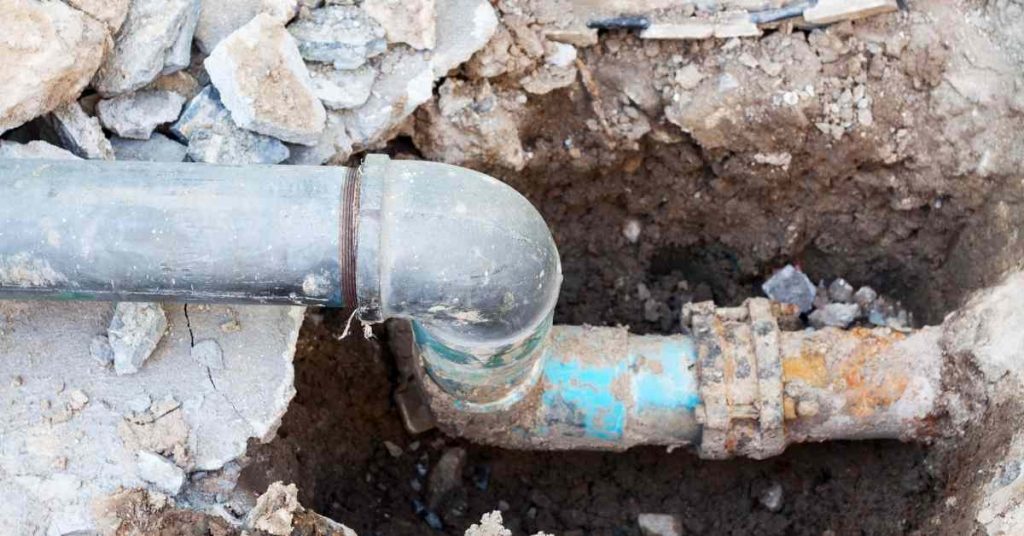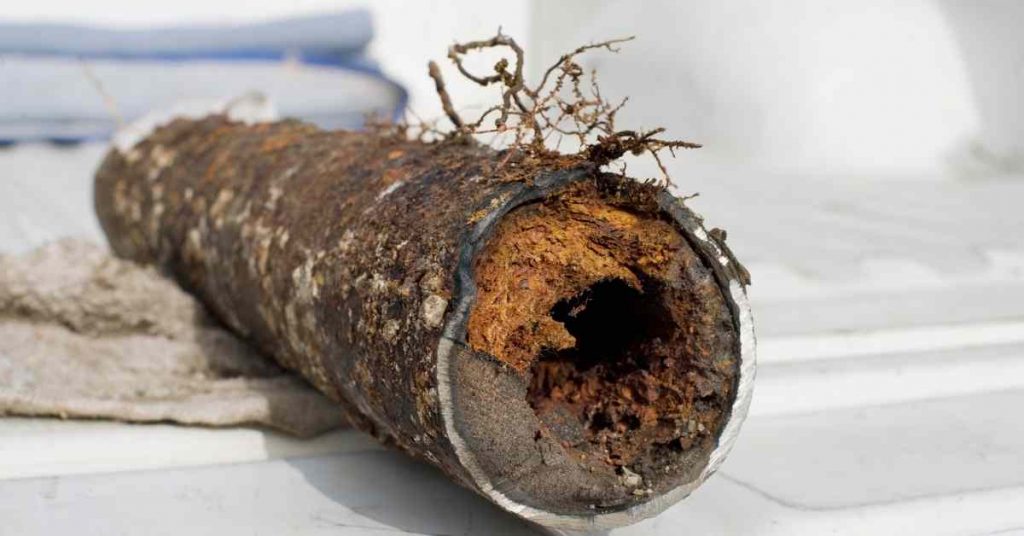
Replacing pipes in your home is a significant undertaking, but it’s essential to do so when necessary to avoid potential water damage and health risks. Here’s a summary of tell-tale signs that indicate it’s time to replace your pipes:
- Frequent Leaks: If you experience frequent leaks, even after repairs, it may indicate that your pipes have become weakened or corroded over time. Replacing them can prevent ongoing water damage and the cost of continuous repairs.
- Low Water Pressure: A noticeable decrease in water pressure throughout your home can signal issues with your pipes. Corrosion and mineral buildup can restrict water flow, necessitating pipe replacement.
- Discolored Water: If your tap water appears discolored, rusty, or has a metallic taste, it may be due to deteriorating pipes. Corroded or rusted pipes can contaminate your water supply, posing health risks.
- Frequent Clogs: Frequent drain and sewer clogs can indicate the presence of old or damaged pipes. Tree root intrusions, mineral buildup, or pipe degradation may require pipe replacement to prevent recurring blockages.
- Unpleasant Odors: Sewer odors emanating from your drains or fixtures can be a sign of damaged or deteriorating sewer pipes. Replacing these pipes is essential for both your health and comfort.
- Visible Corrosion: Inspect exposed pipes for signs of corrosion, rust, or flaking. Visible deterioration is a clear indication that your pipes are in poor condition and should be replaced.
- Aging Pipes: If your home has outdated pipes made of materials such as galvanized steel, lead, or polybutylene, it’s a good idea to consider replacement as these materials are prone to corrosion, leaks, and health hazards.
- Water Damage: If you’ve experienced water damage to your home’s structure, walls, or flooring due to pipe leaks, it’s crucial to address the underlying issue by replacing the damaged pipes to prevent future incidents.
- Noisy Pipes: Unusual noises, such as banging or clanging, when using water fixtures can indicate issues with your pipes, including loose connections or water hammer. These issues may warrant pipe replacement to restore quiet and efficient plumbing.
- Health Concerns: If you suspect or have confirmed that your home has lead pipes, it’s critical to replace them to eliminate the risk of lead contamination in your drinking water.
How Do I Know When to Replace My Pipes?

The following are the signs that you need to replace your plumbing pipes:
1. The Pipes are Too Old
Plumbing pipes do not last forever. At one point, they will need to be replaced. Water pipes do not however have the same lifespan. Some pipes last longer than others.
In most old homes, water pipes are mostly made from galvanized steel. Galvanized steel is basically steel pipes which have been coated with a zinc layer to prevent corrosion.
These were the pipes of choice after lead and polybutylene pipes stopped being used. They were safe and could last for a long time thanks to the zinc coating.
What building professionals did not anticipate at the time is that the zinc coating would eventually peel off, subjecting the pipes to oxygen and therefore corrosion was inevitable.
When a pipe starts to corrode, its structural integrity is compromised and it is therefore just a matter of time until the pipe starts to leak.
Despite this challenge, galvanized steel pipes lasts for 80 or even 100 years depending on water quality and maintenance. These pipes are however no longer installed for the reasons I have outlined in this post.
If you house has galvanized steel pipes that are older than 80 years, you should start to plan for their replacement. This is especially the case if they have been having other issues like leaks or low water pressure.
Although not common, some houses have brass water pipes. Just like galvanized steel, brass water pipes last for 80 to 100 years so start planning for their replacement if they are approaching their 80th birthday.
Copper pipes are the pipes being installed in most homes today alongside plastic (PEX) pipes. They however don’t last as long as galvanized steel and brass pipes despite their cost.
Although copper pipes do not rust, they are badly affected by acidic water which accelerates their corrosion, reducing their lifespan. They are also thinner compared to the other pipes meaning they crack easily.
The lifespan of copper water pipes is between 70 and 80 years. If the pipes in your house are made from copper and are approaching or are past 70 years then you need to have them replaced lest they fail when you are not ready.
Plastic (PEX) pipes have the lowest lifespan. They last for 30 to 50years although some reports indicate they can last for more than 100 years. It is hard to really tell since they have not been in use for as long as galvanized steel pipes.
PEX is especially affected by chlorine, hot water and direct exposure to sunlight and that is why it does not last long. The pipes could however last longer if well -taken care of.
Replacing old galvanized steel pipes with PEX is however the most preferred method today as it is so cheap and fast. You can snake PEX pipes through walls without cutting through them and you do not need a big crew to do the job.
If you already have PEX pipes in your house that are more than 40 years old, start to plan for their replacement.
So, how long do drain pipes last? Well, it depends on the material of the pipes. In modern plumbing, PVC drain lines are the most preferred but in the past cast-iron pipes were installed almost everywhere.
While cast-iron pipes last longer (80 to 100 years) compared to PVC drain pipes (25 to 40 years), PVC drain pipes are so easy and cheap to install and are not affected by tree roots as much as cast-iron pipes.
In short, replace your cast-iron drain pipes if they are 80 to 100 years old and PVC drain lines if they are 25 to 40 years old.
2. Unsafe Pipe Material
If your house was built before 1986, there is a very big chance that your water service line is made from lead. The service line is the main water line connecting your house to the city’s water line near the street.
It is usually buried in your front yard. What may surprise you is that it is very possible to have copper or galvanized steel water pipes in your house but the service line is made from lead.
Needless to say, lead is a very dangerous metal, especially to young children and pregnant people. It especially damages the brain and nervous system, resulting in slow growth, learning and behavior problems.
To check if you have lead water pipes in your house, look for an exposed section of your service line. If the pipe is dark gray in color, non-magnetic and is shiny when scratched, you definitely have lead pipes.

I have written a detailed post on everything you need to know about houses with lead pipes. Read it here.
If not lead, your house could as well have polybutylene pipes or “Poly B” as they are commonly known. So, what is wrong with polybutylene pipes and why do you need to replace them.
Taunted as the pipes of the future and having been installed in about 10 million homes, polybutylene pipes were banned by the building code but not before an almost 1 billion dollar lawsuit.
Years after their installation, it was discovered that elements in water like chlorine made the pipes brittle and micro fractures would start to develop. Once enough fractures develop, the pipe will suddenly burst resulting in leaks and therefore water damages.
There are still many houses with polybutylene pipes in the Unites States. If you your house has these type of pipes, you should replace them as soon as possible before the inevitable happens.
Should you buy a house with polybutylene pipes though? Check out my post on that issue here.
3. Low Water Pressure
Are you having low water pressure in your house? It may be time to replace your pipes. But how exactly do bad pipes affect water pressure?
After years of corrosion, mineral deposits builds up inside the pipe, effectively reducing their internal diameter. Due to the reduced diameter, the volume of water that can flow through the pipe is considerably reduced.

You however don’t need to replace your pipes every time you are having low pressure. Sometimes the pressure has nothing to do with your pipes.
Start by adjusting the water pressure at the pressure reducing valve and check if that will restore it. Cleaning shower heads and faucet aerators will also remove the mineral build up clogging them and hence increase the water pressure.
Another thing you can do to increase the water pressure in your house is descaling your pipes. You can do this yourself or hire a plumber to do it for you.
If you have tried all the above but still the water pressure in your house is too low, replacing the pipes is the only solution. This especially makes sense if the pipes are too old as well.
4. Discolored Water

Needless to say, water has no taste and definitely no color. If however the water flowing out of your pipes is brown, black or another color, it could be time to have your pipes replaced.
Brown water from pipes is often caused by corrosion. This happens when you have cast-iron pipes.
The zinc layer coating the pipes peel off after a few years and the pipe starts to corrode forming iron oxide (rust) which is brown in color. The rust dissolves in water and hence the brown water.
The more the pipe corrodes the more its structural integrity is compromised and the more it is likely to leak. Usually, this pipes starts to corrode and leak around joints.
It is possible to have low water pressure from your pipes which is discolored at the same time. Sometimes cleaning the pipes (hydro jetting) will fix the problem but if the pipes are too old the water pressure from hydro jetting will destroy them.
You may need to hire a plumber to advise you whether descaling your pipes is the way to go or if you need to have them replaced.
Note: Not every time you have discolored water that your pipes are responsible for it. Sometimes it could be an old water heater or even the city water department flushing their lines or testing hydrants.
6. Frequent Leaks

Because water supply pipes are always under pressure, leaks do occur but they should not be very frequent. The thing about leaks is that if not fixed immediately they can cause extensive water damages.
Leaks in water pipes are directly proportional to the age of the pipes. Old pipes will definitely leak more frequently compared to newer ones.
If you the pipes in your house are leaking frequently are older than 80 years and you frequently experience discolored water or low water pressure in may be time to have them replaced.
6. Slow Drains and Sewer Backups
This applies to drain pipes and not water supply pipes. As I mentioned, drain pipes unlike water supply pipes depend on gravity to drain out wastewater.
The pipes therefore need to be clear otherwise wastewater will not flow out and will instead backup to the house.
After years of usage sewer lines develop cracks, allowing tree roots to grow inside the pipes. When a thick network of tree roots has developed inside the pipes, waste will not flow out of the house and you will always be experience clogs or even sewage backups.

The good thing is that if the pipes is still in good condition, you can still rod the sewer line and remove the tree roots and pipe scale.
Another method of cleaning a sewer line and remove tree roots, sludge and clogs is through hydro jetting. This is the use of pressurized water (up to 5000 psi) to clean the pipes.
Drain pipes will however need to be replaced if the lines have collapsed or are bellied (sagging pipes). As this is not something you can find out on your own, a professional plumber will come over and inspect your drain pipes using a camera and advise you what is best to do.
Conclusion
And basically those are the telltale signs that you need to replace you pipes. I hope you found this article helpful.





